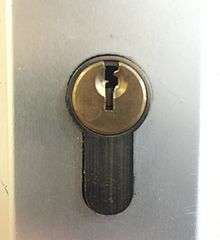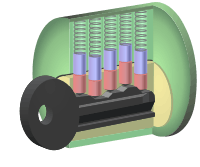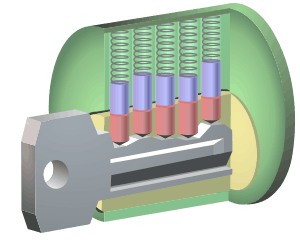Pin tumbler lock

The pin tumbler lock (or Yale lock, after lock manufacturers Yale) is a lock mechanism that uses pins of varying lengths to prevent the lock from opening without the correct key. Pin tumblers are most commonly employed in cylinder locks, but may also be found in tubular pin tumbler locks (also known as radial locks or ace locks).
History
The first tumbler lock was found in the ruins of the Palace of Khorsabad in Iraq.[1] Basic principles of the pin tumbler lock may date as far back as 4000 BC in Egypt; the lock consisted of a wooden post affixed to the door, and a horizontal bolt that slid into the post. The bolt had vertical openings into which a set of pins fitted. These could be lifted, using a key, to a sufficient height to allow the bolt to move and unlock the door.[2] This wooden lock was one of Egypt's major developments in domestic architecture during classical times.[1]


In 1805, the earliest patent for a double-acting pin tumbler lock was granted to American physician Abraham O. Stansbury in England. It was based on earlier Egyptian locks and Joseph Bramah's tubular pin tumbler lock. Two years later, Stansbury was granted a patent in the United States for his lock.[3]
In 1848, Linus Yale, Sr. invented the modern pin-tumbler lock.[4] In 1861, Linus Yale, Jr. was inspired by the original 1840s pin-tumbler lock designed by his father, thus inventing and patenting a smaller flat key with serrated edges as well as pins of varying lengths within the lock itself, the same design of the pin-tumbler lock in use today.[5]
Design
The pin tumbler is commonly used in cylinder locks. In this type of lock, an outer casing has a cylindrical hole in which the plug is housed. To open the lock, the plug must rotate.
The plug has a straight-shaped slot known as the keyway at one end to allow the key to enter the plug; the other end may have a cam or lever, which activates a mechanism to retract a locking bolt. The keyway often has protruding ledges that serve to prevent the key pins from falling into the plug, and to make the lock more resistant to picking. A series of holes, typically five or six of them, are drilled vertically into the plug. These holes contain key pins of various lengths, which are rounded to permit the key to slide over them easily.
Above each key pin is a corresponding set of driver pins, which are spring-loaded. Simpler locks typically have only one driver pin for each key pin, but locks requiring multi-keyed entry, such as a group of locks having a master key, may have extra driver pins known as spacer pins. The outer casing has several vertical shafts, which hold the spring-loaded pins.
When the plug and outer casing are assembled, the pins are pushed down into the plug by the springs. The point where the plug and cylinder meet is called the shear point. With a key properly cut and inserted into the groove on the end of the plug, the pins will rise causing them to align exactly at the shear point. This allows the plug to rotate, thus opening the lock. When the key is not in the lock, the pins straddle the shear point, preventing the plug from rotating.




Cylinder locks

Commonly pin tumbler locks are found in a cylinder that can be easily unscrewed by a locksmith to facilitate rekeying. The first main advantage to a cylinder lock, also known as a profile cylinder lock or euro, is that the cylinder can be changed without altering the boltwork hardware. Removing the cylinder typically requires only loosening a set screw, then sliding the cylinder from the boltwork. The second is that it is usually possible to obtain, from various lock manufacturers, cylinders in different formats that can all be used with the same type of key. This allows the user to have keyed-alike, and master-keyed systems that incorporate a wide variety of different types of lock, such as nightlatches, deadbolts and roller door locks.
Typically, commercial padlocks can also be included, although these rarely have removable cylinders. Standardised types of cylinder include:
- Rim mounted (also known as night latch cylinders)
- Euro cylinders
- Key-in-knobset cylinders
- Ingersoll format cylinders
- American, and Scandinavian round mortise cylinders
- Scandinavian oval cylinders
There are also standardised cross-sectional profiles for lock cylinders that may vary in length - for example to suit different door thicknesses. These profiles include the europrofile (or DIN standard), the British oval profile and the Swiss profile
Some types of cylinder lock are vulnerable to an attack called lock snapping.
Electronic / digital cylinder

An electronic / digital cylinder is a locking device which operates by means of electric current. Electric locks are sometimes stand-alone with an electronic control assembly mounted directly to the lock. More often electric locks are connected to an access control system.: The advantages of an electric lock connected to an access control system include: key control, where keys can be added and removed without re-keying the lock cylinder; fine access control, where time and place are factors; and transaction logging, where activity is recorded.
Master keying
A master keyed lock is a variation of the pin tumbler lock that allows the lock to be opened with two (or more) different keys. This type is often used for doorlocks in commercial buildings with multiple tenants, such as office buildings, hotels, and storage facilities. Each tenant is given a key that only unlocks his own door, called the change key, but the second key is the master key, which unlocks all the doors, and is usually kept by the building manager, so he can enter any room in the building.
In a master keyed lock, some or all of the pin stacks in the lock have three pins in them instead of two. Between the driver pin and the key pin is a third pin called the spacer pin. Thus each pin line has two shear points, one where the driver and spacer pins meet, and one where the spacer and key pins meet. So the lock will open with two keys; one aligns the first set of shear points and the other aligns the second set of shear points. The locks are manufactured so one set of shear points is unique to each lock, while the second set is identical in all the locks. A more secure type of mechanism has two separate tumblers, each opened by one key.
More complicated master-key lock systems are also made, with two or more levels of master keying, so there can be subordinate master keys that open only certain subsets of the locks, and a top-level master key that opens all the locks.
Individually keyed system (KD)
With an individually keyed system, each cylinder can be opened by its unique key.
Keyed alike (KA)
This system allows for a number of cylinders to be operated by the same key. It is ideally suited to residential and commercial applications such as front and back doors.
Master keyed (MK)
A master-keyed system involves each lock having its own individual key which will not operate any other lock in the system, but where all locks can be operated by a single master-key. This is usually applied in commercial environments.
Grand master keyed (GMK)
This is an extension of the master-keyed system where each lock has its own individual key and the locks are divided into 2 or more groups. Each lock group is operated by a master-key and the entire system is operated by one grand master-key. This is ideally utilized in complex commercial systems.
Common entrance suite / Maison keying (CES)
This system is widely used in apartments, office blocks and hotels. Each apartment (for example) has its own individual key which will not open the doors to any other apartments, but will open common entrance doors and communal service areas. It is often combined with a master-keyed system in which said key is kept by the landlord.
Vulnerabilities
Lock Picking
The basic pin tumbler lock alone is vulnerable to several lock picking methods and attacks, the most common ones used by criminals being lock bumping and snap guns. To combat this, many higher security cylinders incorporate the use of specialised pins known as security pins which are designed to catch in the lock cylinder if a snap gun or bump key is used.
Lock Snapping
Lock snapping is a method of forced entry that only affects certain types of cylinder lock, such as the euro cylinder which are commonly found on uPVC doors in Europe.[6] Lock snapping is when a force is applied to the lock cylinder, usually with a pair of mole grips / locking pliers and ripped out from the door - allowing access to the latch mechanism.[7][8] It can take between 50 seconds and 2 minutes to snap the lock and gain entry.[6][9] Police in the UK have estimated that around 22 million doors throughout the country could be at risk from lock snapping.[10]
Lock snapping is possible because the lock has a weakness where the retaining bolt passes through a thinner part of the lock. A recent development is to build a lock with a front section that snaps off the main body leaving enough lock that prevents access to the operating latch. Some designs feature more than one sacrificial section which stops the door being opened from the attacked side (even with the key), but the door can be opened from the other side. Most locks sold in the UK since 2010 have been designed to reduce the risk of this attack. You can reduce the threat of cylinder snapping by using cylinders designed to prevent the method of attack, cylinders that prevent this method of attack will meet TS007 3 standard. TS007 3 star cylinders will preferably be fitted in conjunction with a high security mechanism and handle set.[11]
See also
- Disc tumbler lock
- Key relevance
- Lock picking
- Magnetic-coded lock
- Tubular pin tumbler lock
- Wafer tumbler lock
Patents
- U.S. Patent 31,278 – Lock
- U.S. Patent 8,071 – Lock
- U.S. Patent 9,850 – Lock and key
References
- 1 2 James, Peter, and I. J. Thorpe. Ancient Inventions. New York: Ballantine, 1994. Print.
- ↑ Locksmithing: From Apprentice to Master. McGraw-Hill Professional. p. 79.
- ↑ The Complete Book of Home, Site, and Office Security: Selecting, Installing, and Troubleshooting Systems and Devices. McGraw-Hill Professional. p. 11.
- ↑ The Geek Atlas: 128 Places Where Science and Technology Come Alive. O'Reilly Media, Inc. p. 445.
- ↑ "Inventor of the Week Archive". Massachusetts Institute of Technology.
- 1 2 "37p locks no match for Huddersfield criminals, warns W Yorks Police chief". Huddersfield Daily Examiner. 3 November 2009. Retrieved 28 May 2015.
- ↑ "Lock Snapping : What is it? Find out more As seen on BBC/ITV". www.euro-secure.com. Retrieved 2016-03-11.
- ↑ North Yorkshire Police, United Kingdom. "Advice relating to Euro cylinder locks". North Yorkshire Police. Retrieved 2016-03-16.
- ↑ "Rise in 'lock snapping' burglaries in West Yorkshire". BBC News. Retrieved 2016-03-16.
- ↑ "Police Advice on Lock Snapping". Lincolnshire Police. Archived from the original on 2013-08-10.
- ↑ Kingdom, North Yorkshire Police, United. "Advice relating to Euro cylinder locks". North Yorkshire Police. Retrieved 2016-03-16.
External links
- The pin tumbler invention at Yale company site
- Popular Science, November 1946 How Your Home Lock Works
- Video on changing a euro cylinder
- Video on lock snapping